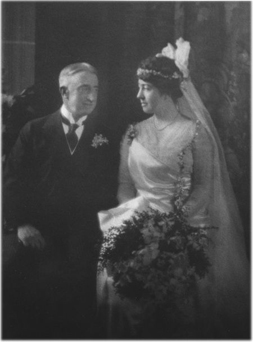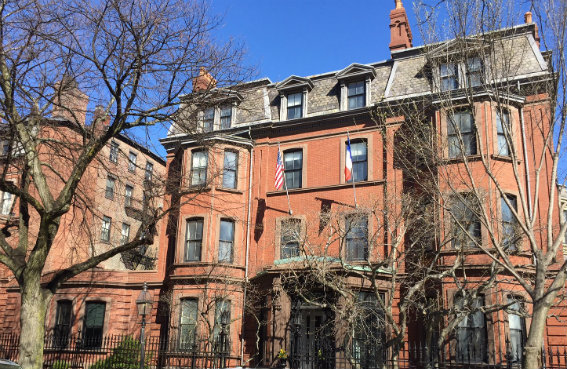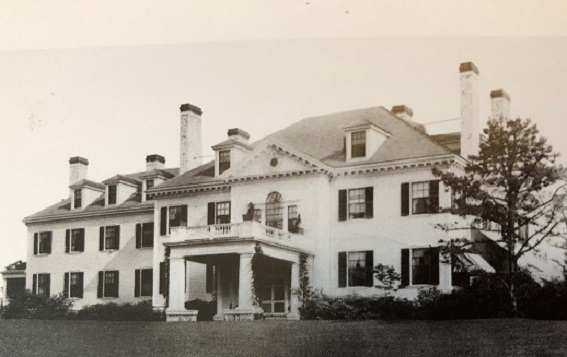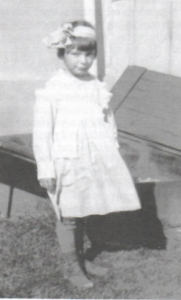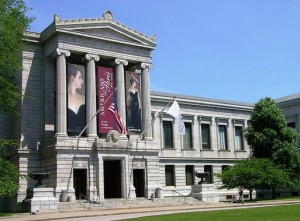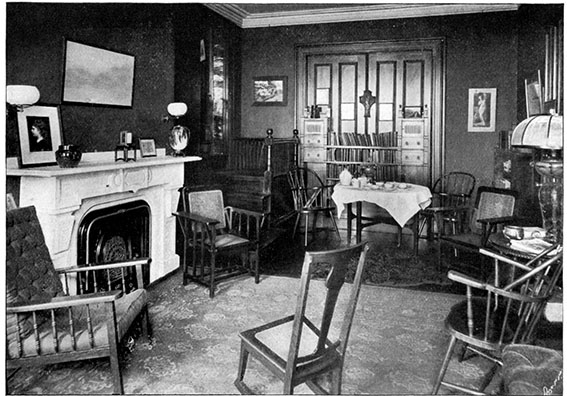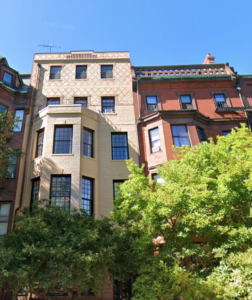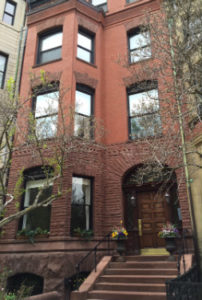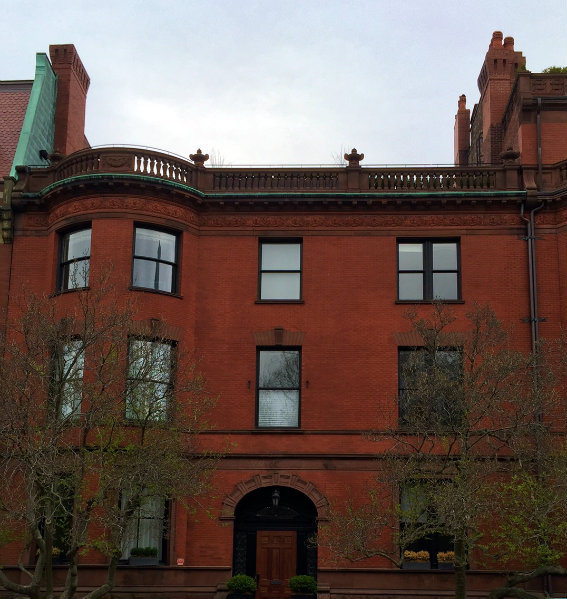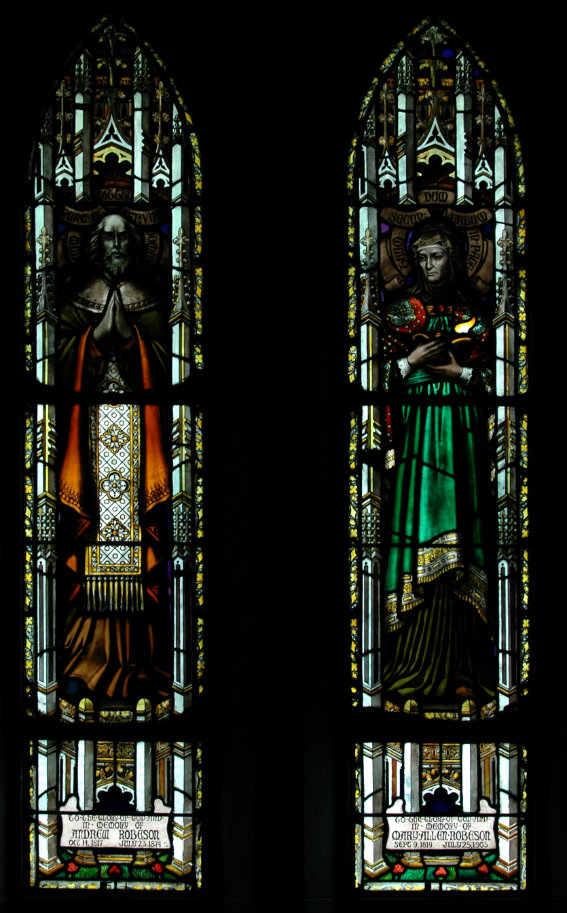- April 21. Parishioner Leslie Lindsey and Stuart Mason married at Emmanuel. She is pictured below with her father, William Lindsey.
- May 7. The Lusitania, upon which the newly weds left for the groom’s home in England, was sunk by a German U-boat. For more detail, please see our Lusitania Centennial.
Tag Archives: benefactors
1914
See also World War I Memorial and Katharine Lane Weems.
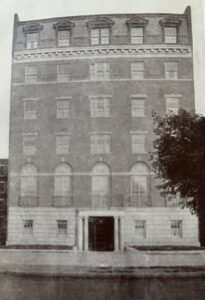 The Students’ House Corporation, under the direction of Mary S. Holmes and Charlotte Upham Baylies, built at 96 The Fenway a home for our Students’ House, which had been in rented quarters since its inception in 1899. They engaged architects Kilham & Hopkins, raised a large portion of its construction cost ($124K), and secured a mortgage for the remainder. The building is now Kerr Hall, a Northeastern University dormitory.
The Students’ House Corporation, under the direction of Mary S. Holmes and Charlotte Upham Baylies, built at 96 The Fenway a home for our Students’ House, which had been in rented quarters since its inception in 1899. They engaged architects Kilham & Hopkins, raised a large portion of its construction cost ($124K), and secured a mortgage for the remainder. The building is now Kerr Hall, a Northeastern University dormitory.
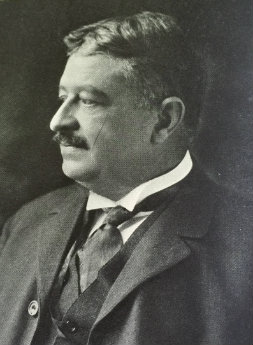
Gardiner Martin Lane from Harvard College Class of 1881 biography of him in the papers of Katharine Lane Weems at the Schlesinger Library, Radcliffe.
October 6. About a thousand people attended the funeral service for financier, philanthropist, and parishioner Gardiner Martin Lane (born 1859). The Rev. Dr. Elwood Worcester, The Rt. Rev. William Lawrence, The Rev. John W. Suter of Winchester, and The Rev. Prescott Evarts from Lane’s Harvard Class of 1881 officiated. Pallbearers included President A. Lawrence Lowell of Harvard, Sen. Henry Cabot Lodge, Charles Francis Adams, and several of his partners from Lee Higginson & Co.. Lynnwood Farnum played a Tchaikovsky funeral march and “Dead March” from Handel’s “Saul”. The boys choir sang “Abide with me” and “The strife is over”.
As treasurer of the New England chapter of the International Red Cross, Lane collected and distributed relief funds for the Salem fire (1914), the San Francisco earthquake (1906), and other disasters. Appointed trustee of the Museum of Fine Arts in 1906, and elected its president in 1907, he oversaw its move from Copley Square to the Evans Building on Huntington Ave., which was designed by Emmanuelite Guy Lowell. Spearheading the Museum’s fundraising effort for the new facility, Lane said, “A mere collection of beautiful objects is of little value unless seen, appreciated, and understood by many.”
His widow, Emma Louise Gildersleeve Lane, and daughter, Katharine Lane Weems, were parishioners for years after his death and generous benefactors to Emmanuel.
1909
-
7 May. Benefactor of our cantata program, Priscilla Rawson (Young) was born in Bayside, NYC to Clementine Herschel of Holyoke MA & Hobart Rawson of Cincinnati OH. She was named for her Mayflower ancestor Priscilla Mullins Alden, who in turn was the namesake of Priscilla, now thought to have been the amanuensis of Paul the Apostle and author of the Epistle to the Hebrews [1]. See also 1939, 1942, 1971, 1973, 1994 & 2000.
- Elwood Worcester and Samuel McComb published The Christian Religion as a Healing Power: A Defense and Exposition of the Emmanuel Movement (NY: Moffat, Yard), full text. It is an addendum to their Religion and Medicine: The Moral Control of Nervous Disorders (NY: Moffat, Yard, 1908), full text.
- Parishioner Ernest Jacoby started a group for alcoholic men with special emphasis on fellowship as a path to recovery. It eventually moved from our basement and continued into the 1930s as the Jacoby Club. The first meeting of Alcoholics Anonymous in Boston was held in 1940 at the Club, then at 115 Newbury Street.
-
The first section of parishioner Guy Lowell‘s design for the Museum of Fine Arts was completed. Lowell (1870-1927) also designed the Charles River Dam (built in 1910) and the Esplanade from the Charlesgate to the dam. For more about him and his other architectural achievements, please see Wikipedia.
1. Ruth Hoppin, Priscilla’s Letter: Finding the Author of the Epistle to the Hebrews. Ft. Bragg CA: Lost Coast Press, 2000.
1905
Tuberculosis Class, organized by Joseph H. Pratt MD and Lesley H. Spooner, MD., reached 308 patients in its first year.
The Rev. Dr. Samuel McComb (1864–1938) became Associate Rector. Raised in Belfast, Ireland, with a doctorate from Oxford University, he had taught church history at Queens University, Ontario, and served as a Presbyterian minister in England and New York City before his ordination in the Episcopal Church. He became a spokesman for the Emmanuel Movement during its active years. See also 1909 and his many works available on Amazon and full text from Hathi Trust.
November 23. Emmanuel Memorial House was dedicated. Given by Harriet Pitts Weeks (Mrs. Silas Reed) Anthony in memory of her father Andrew Gray Weeks, whose widow gave its playground. It was located at 11 Newcomb St. around the corner from 1906 Washington St., where our diocese maintained a mission in the South End, Church of the Ascension (now Grant African Methodist Episcopal Church). Through the Emmanuel House Committee, Emmanuel parishioners helped with the kindergarten and summer play school for neighborhood children. They also ran homemaking and other classes and a gymnasium for Ascension parishioners. 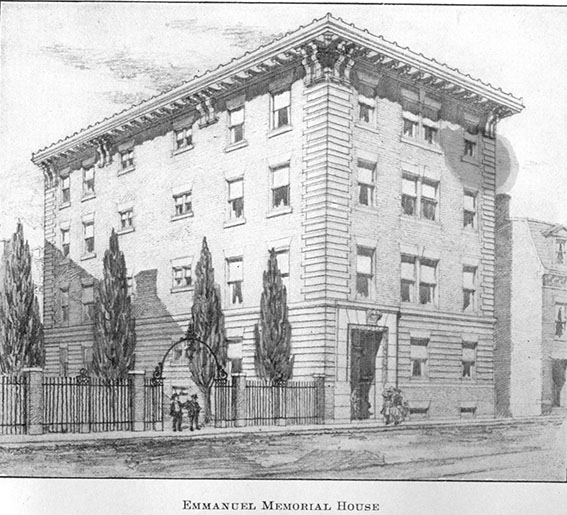
1903
June 26. Andrew Gray Weeks died. Having been born in Portland, Maine, in 1823 and confirmed by Dr. F. Dan Huntington, he served on our vestry (1879-82 & 1884) and as junior warden from 1885 until his death. Having become a successful merchant, Andrew was generous to our church and those less fortunate. In 1905 his sister Harriet (Mrs. Silas Reed) Anthony gave in his memory the playground for the Emmanuel Memorial House, which his widow Alice gave. She also paid for a brass memorial plaque for their son Kenneth, who fell at Givenchy, France, in 1915. 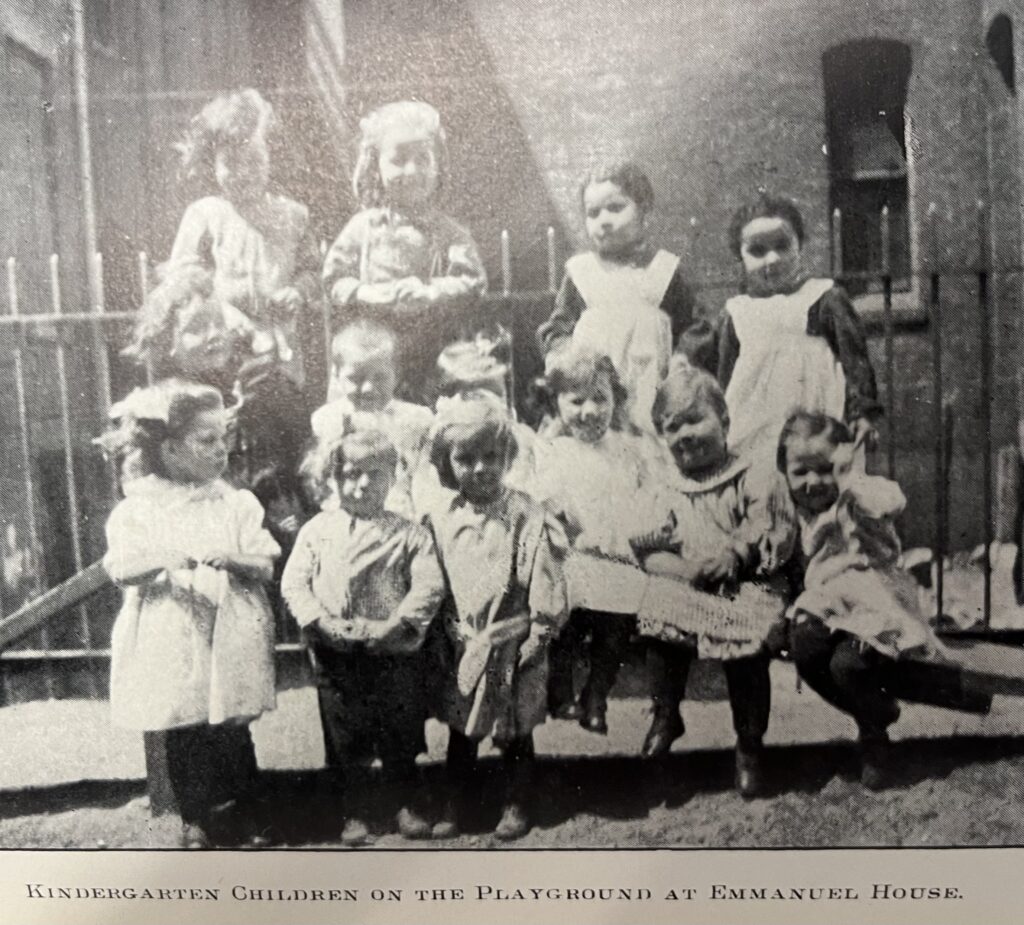
1899
- The new sanctuary was dedicated.
-
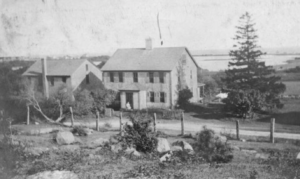
Fay Cottage @ 216 Elm Rd., Falmouth MA was built c1740 by David Butler. 1916 photo thanks to Woods Hole Historical Archive
A cottage overlooking the Vineyard Sound in Falmouth was provided for a summer-long series of 10-day seaside sojourns for women and children of the Church of the Ascension by Emmanuel parishioners Mr. & Mrs. Henry B. Fay. A piazza and bathhouses along its beach were constructed with Emmanuel funds. Sarah M. Gay assisted Clara M. Carter, the Diocesan Deaconess, in managing the retreat at Fay Cottage for the first of 25 years to come. See also history of Fay Farm.
- The Students’ House was rented at 21-23 St. James Ave. It housed about 20 young women and maintained a club for 150 others for more than a decade.
1898
- Henrietta Sargent, daughter of our benefactor Mary Robeson Sargent (1847-1919) and Charles Sprague Sargent, married architect Guy Lowell at Emmanuel. CSS has a botanical legacy in the Professor Sargent camellia, which was released in 1908.
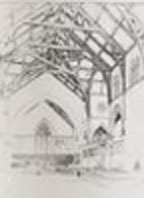 April 19. Francis R. Allen‘s plans were approved and work began on the expansion.
April 19. Francis R. Allen‘s plans were approved and work began on the expansion.
- Florence R. Rhodes rented a cottage on Sandy Pond in Lincoln MA as a summer camp for girls of Church of the Ascension, which was run by Deaconess Henrietta Goodwin and Helen E. Moulton, intern from the NY Training School for Deaconesses.
1894
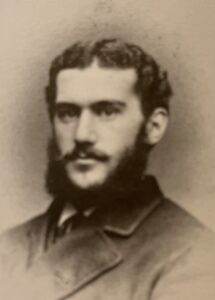 August 15. Architect and vestryman Arthur Rotch died of pleurisy at the age of 44. In 1892, he had moved to 82 Commonwealth Avenue with his bride Lisette DeWolf Colt. Son of Benjamin and Annie Rotch, founding members of Emmanuel, Arthur had graduated from Harvard College in 1871, studied architecture at MIT in 1872-3, and then gone to Paris to study at the Ecole des Beaux-Arts. In 1880, he joined George Tilden in designing houses at 197, 211, 215, 231 & 233 Commonwealth Avenue, among others. In 1886, with associate Ralph Adams Cram, they built Church of the Holy Spirit, Mattapan. In 1889, they designed a mission chapel for Emmanuel, which was never realized.
August 15. Architect and vestryman Arthur Rotch died of pleurisy at the age of 44. In 1892, he had moved to 82 Commonwealth Avenue with his bride Lisette DeWolf Colt. Son of Benjamin and Annie Rotch, founding members of Emmanuel, Arthur had graduated from Harvard College in 1871, studied architecture at MIT in 1872-3, and then gone to Paris to study at the Ecole des Beaux-Arts. In 1880, he joined George Tilden in designing houses at 197, 211, 215, 231 & 233 Commonwealth Avenue, among others. In 1886, with associate Ralph Adams Cram, they built Church of the Holy Spirit, Mattapan. In 1889, they designed a mission chapel for Emmanuel, which was never realized.
In 1886, Arthur became a member of the Corporation of MIT and served as chairman of its Department of Architecture until his death. Having with his sisters established in 1883 the Rotch Traveling Scholarship in memory of their father, he bequeathed funds for the Rotch Library at MIT. He was chairman of Harvard’s Visiting Committee of Fine Arts, founder of the Boston Architectural Club, trustee of the Museum of Fine Arts, and trustee and benefactor of the Mass. Eye & Ear Infirmary. Our Rotch Reredos was given by his sister Aimee Sargent in memory of him, their sister Edith. and their parents.
See also
- Wikipedia’s entry for Arthur & for a list of their works Rotch & Tilden
- Back Bay Houses for their works in the Back Bay
- Bainbridge Bunting‘s Houses of Boston’s Back Bay (Cambridge: Harvard U. Press, 1967) discusses several of their works in depth.
- A Continental Eye: The Art and Architecture of Arthur Rotch: the Catalogue of an Exhibition Held at the Boston Athenæum, December 10th, 1985, through January 24th, 1986, and at the Klimann Gallery of the MIT Museum, February 10th through April 5th, 1986, by Harry L. Katz and Richard Chafee.
1873
Several famous botanists were connected with our church.
-
When Benjamin Tyler Reed retired as senior warden, Edward Sprague Rand served again as warden until 1875. His son E.S. Rand, Jr. (actually III) wrote many botanical works. An orchid and a rhododendron are named for him (or perhaps his father).
- Henry Winthrop Sargent (1810-1882) became junior warden. In 1859 and 1875, he published supplements to Downing’s reference work, A Treatise on the Theory and Practice of Landscape Gardening (1841).
- Dec. 2. Winthrop Henry Sargent (1840-1916, son of H.W. & Caroline Olmsted S.) married Aimee Rotch, daughter of Emmanuel charter members Benjamin S. and Annie Bigelow Rotch. They lived at 207 Commonwealth Avenue. Winthrop served for 30 years as warden of St. Luke’s Chapel, Fishkill-on-Hudson, NY, where the Sargents summered. See also:
- Rotch Reredos
- Henry Winthrop Sargent and His Family
- Register of the Mass. Society of Colonial Dames of America: 1893-1905, (p. 83, #144) lists some of Aimee’s ancestors including Emmanuelites Amos & Nathaniel Lawrence.
- The Rev. Dr. A.H. Vinton officiated at the wedding of Mary Allen Robeson (1853-1918), daughter of charter members Andrew (1817-1874) and Mary Allen Robeson (1819-1903), and Charles Sprague Sargent (cousin of H.W. S.), who founded the Arnold Arboretum and wrote many botanical works. Andrew and his wife Mary Allen Robeson lived at Holm Lea across from Fairsted in Brookline. They were memorialized by their daughter Alice Robeson (Mrs. Stephen Van Rensselaer) Thayer in our windows depicting Simeon and Anna. See also:
- Register of the Mass. Society of Colonial Dames of America: 1893-1905, (p. 48, #41) lists Mary’s ancestors who served the Commonwealth.
- Register of the Mass. Society of Colonial Dames of America: 1893-1905, (p. 57, #66) lists even more of Alice’s ancestors.


